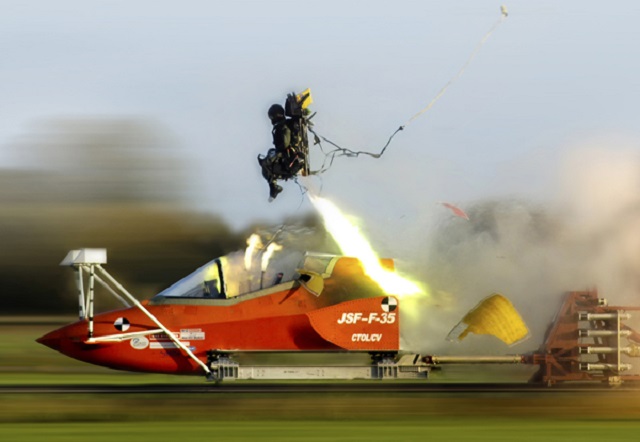The US Air Force is demanding a long-term fix to the Martin Baker US16E (MK16) ejection seat for the Lockheed Martin F-35, after recent tests discovered “unacceptable risk of neck injury” for light-weight pilots during parachute deployment at low speeds.
The issue is serious enough that flying has been restricted to pilots weighing between 61.7kg (136lb) and 111.1kg, removing just one pilot from the programme. But a recent statement by service officials says risk extends to pilots weighing up to 74.8kg, although probability of ejection at low speed has been deemed low and those pilots are still flying.
The issue is compounded by the introduction of a third-generation helmet-mounted display (HMD) produced by VSI, the Rockwell Collins and Elbit Systems of America joint venture. Like other advanced fighter HMDs, the latest VSI helmet is heavy and adds strain on lighter-weight pilots during ejection.
In response, the F-35 Joint Programme Office says it is pursuing three potential fixes, including a switch for lightweight pilots to slightly delay parachute deployment, thereby reducing its opening force. The second and third fixes involve reducing the weight of the helmet and sewing a fabric head support panel between the parachute risers to stop the pilot’s head from moving backward as the parachute opens. Opportunities to reduce the helmet’s weight are scarce, but options include removing some internal strapping material and eliminating one external visor, officials say.
“Both the weight switch modification and the head support panel are scheduled to be introduced when the next upgrade of the ejection seat is available near the end of 2016,” the programme office says in an email. “A preliminary design review on the improved helmet is schedule for December. All three fixes will be fully implemented by summer 2017.”

Martin-Baker
The air force still expects to achieve initial operational capability in 2016 despite the issue, confirms USAF chief of staff Gen Mark Welsh.
The US16E is designed to be safe for pilots weighing 46.7kg to 111.1kg, and the air force doesn’t appear to be budging on that performance requirement, despite the issue not impacting more than one USAF pilot (who has since moved to another programme) and none from the US Navy or Marine Corps.
A report by the Pentagon’s Inspector General in March shows a similar limitation already exists for the UTC Aerospace Systems Advanced Concept Ejection Seat II (ACES II), which is on 12 platforms including the Lockheed F-16 and Boeing F-15 – both support NVGs and the relatively bulky Joint Helmet-Mounted Cueing System (JHMCS).
The US Navy’s Navy Aircrew Common Ejection Seat (NACES) SJU-17 is rated for pilots weighing between 61.7kg and 96.6kg, the report notes. That ejection seat is installed in the Boeing F/A-18E/F Super Hornet and EA-18G Growler, and both platforms support NVGs and JHMCS.
The US16E is common across the F-35 fleet to include the carrier and short-takeoff-vertical-landing variants, except there are differences in the way the F-35B ejects because of its ability to hover.
According to the air force, there is an “elevated level of risk” for pilots between 61.7kg and 74.8, but the probability of ejection in that slow flight regime is “one in 100,000 flight hours”.
Source: FlightGlobal.com



















